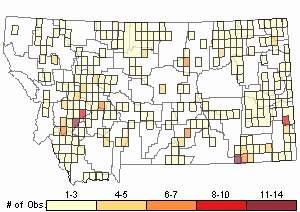View in other NatureServe Network Field Guides
NatureServe
Montana
Utah
Wyoming
Idaho
Wisconsin
British Columbia
South Carolina
Yukon
California
New York
Cherry-faced Meadowhawk - Sympetrum internum
Native Species
Global Rank:
G5
State Rank:
S5
(see State Rank Reason below)
Agency Status
USFWS:
USFS:
BLM:
External Links
State Rank Reason (see State Rank above)
Most abundant and widespread meadowhawk in the state.
General Description
The cherry-faced meadowhawk is a small-sized, red dragonfly, each wing somewhat clear with reddish stigmas. This is Montana's most ubiquitous and widespread meadowhawk. Thorax dark red, abdomen brillant red on top, with some black triangles approaching from underneath. Occurs in many types of lentic habitats, including ponds and marshes that dry up in the summertime.
Phenology
Adult flight season is June to Sept (Paulson 2009).
Species Range
Montana Range
Range Descriptions

 Native
Native
Range Comments
This species is found from Alaska east to Hudson Bay, extending south through the U.S. from California east to Missouri and Pennsylvania. It occurs throughout Montana.
Observations in Montana Natural Heritage Program Database
Number of Observations: 448
(Click on the following maps and charts to see full sized version)
Map Help and Descriptions
Relative Density

Recency



 (Observations spanning multiple months or years are excluded from time charts)
(Observations spanning multiple months or years are excluded from time charts)
Migration
This meadowhawk can be found some distance from water sources as it wanders in search of new habitats to colonize.
Habitat
The preferred habitat of the Cherry-faced Meadowhawk is shallow ponds and lakes, often ones that dry up in summer, as well as marshes, bogs, and slow streams (Dunkle 2000, Paulson 2009).
National Vegetation Classification System Groups Associated with this Species
Grassland
Lowland - Prairie Grassland
Montane - Subalpine Grassland
Wetland and Riparian
Alkaline - Saline Wetlands
Alpine Riparian and Wetland
Peatland
Riparian and Wetland Forest
Riparian Shrubland
Wet Meadow and Marsh
Food Habits
Larvae feed on a wide variety of aquatic insects, such as mosquito larvae, other aquatic fly larvae, mayfly larvae, and freshwater shrimp. They will also eat very small fish and tadpoles.
Adult- The dragonfly will eat almost any soft-bodied flying insect including mosquitoes, flies, small moths, mayflies, and flying ants or termites.
Ecology
The larvae live in debris on the bottom of ponds, lakes, and streams. They do not actively pursue prey, but are sit and wiat predators. Naiads emerge as adults at night. Adults generally fly from early July to October. Hunting occurs from perches on rocks or bare branches. This species has a high tolerance for cold climates, and is found as far north as the Great Slave Lake in the Northwest Territories of Canada
Reproductive Characteristics
Male Cherry-faced Meadowhawks are territorial and oviposition is usually completed in tandem where the eggs are dropped while in flight onto moist substrate (Dunkle 2000, Paulson 2009).
Stewardship Responsibility
Threats or Limiting Factors
Populations are widespread, abundant, and secure.
References
- Literature Cited AboveLegend:
 View Online Publication
View Online Publication Dunkle, S.W. 2000. Dragonflies through binoculars: A field guide to dragonflies of North America. New York, NY. Oxford University Press. 266 pp.
Dunkle, S.W. 2000. Dragonflies through binoculars: A field guide to dragonflies of North America. New York, NY. Oxford University Press. 266 pp. Paulson, D.R. 2009. Dragonflies and Damselflies of the West. Princeton University Press, Princeton. 535 pp.
Paulson, D.R. 2009. Dragonflies and Damselflies of the West. Princeton University Press, Princeton. 535 pp.
- Additional ReferencesLegend:
 View Online Publication
View Online Publication
Do you know of a citation we're missing? Acorn, J. 2004. Damselflies of Alberta: flying neon toothpicks in grass. Edmonton, Alberta: University of Alberta Press. 156 pp.
Acorn, J. 2004. Damselflies of Alberta: flying neon toothpicks in grass. Edmonton, Alberta: University of Alberta Press. 156 pp. Hendricks, P., S. Lenard, D.M. Stagliano, and B.A. Maxell. 2013. Baseline nongame wildlife surveys on the Fort Peck Indian Reservation. Report to the Assiniboine and Sioux Tribes of the Fort Peck Indian Reservation. Montana Natural Heritage Program, Helena, MT. 83 p.
Hendricks, P., S. Lenard, D.M. Stagliano, and B.A. Maxell. 2013. Baseline nongame wildlife surveys on the Fort Peck Indian Reservation. Report to the Assiniboine and Sioux Tribes of the Fort Peck Indian Reservation. Montana Natural Heritage Program, Helena, MT. 83 p. Nelson, Howard E. 1953. The summer dragonflies of Flathead Valley, Montana. M.A. Thesis. University of Montana. Missoula, MT.
Nelson, Howard E. 1953. The summer dragonflies of Flathead Valley, Montana. M.A. Thesis. University of Montana. Missoula, MT. Sater, S. 2022. The insects of Sevenmile Creek, a pictorial guide to their diversity and ecology. Undergraduate Thesis. Helena, MT: Carroll College. 242 p.
Sater, S. 2022. The insects of Sevenmile Creek, a pictorial guide to their diversity and ecology. Undergraduate Thesis. Helena, MT: Carroll College. 242 p.
- Web Search Engines for Articles on "Cherry-faced Meadowhawk"
- Additional Sources of Information Related to "Insects"





